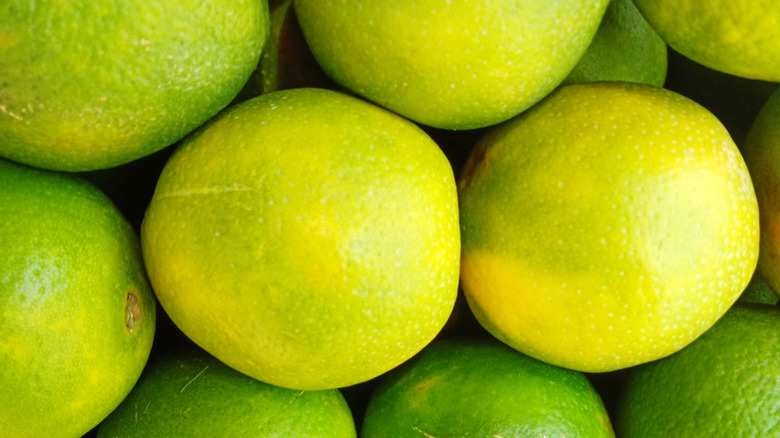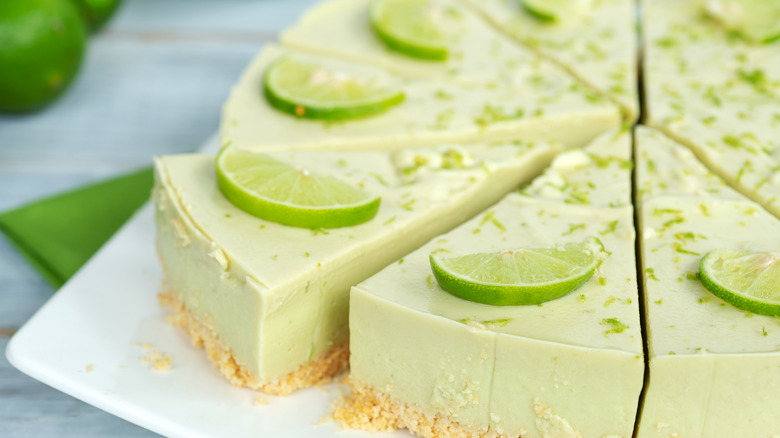What To Consider Before Cooking With Sweet Limes
The words "sweet" and "lime" seem counterintuitive, to say the least. But just because a fruit bears the lime name doesn't mean it's a pucker-inducing citrus with a tangy tart disposition. Unlike the more well-known key, Persian, or Mexican limes sold widely in North America, this sweet little cousin from another continent bears its own distinct characteristics.
When cooking with sweet limes, two considerations emerge, and they're not to be taken lightly. Sweet limes are, as the name implies, much sweeter than what many chefs expect when creating a lime-centric recipe. And they lack the acidity and sour tartness of other lime varieties, instead harboring a mild, sweet flavor with a smoothness likened to honey.
As you can imagine, adding a splash of sweet lime juice to a cocktail, lime dessert, dressing, or main dish will lack the customary punchy tang. Instead, your fiesta lime chicken recipe or frozen lime daiquiri will be less sour, sweeter, and intensely aromatic. Even so, it's not impossible to substitute sweet limes for key limes in your cooking — but do you want to? Maybe not, when the little sweeties hold some culinary magic of their own.
Sweet limes across the globe
Though they share the same "lime" moniker, sweet limes are a different genus within the Citrus family, known as Citrus limettioides. Their origins are far from a certainty, but most accounts trace them back to India, where they're still grown commercially under the name of mosambi. They're likely a hybrid of Mexican limes and sweet lemons or sometimes sweet citrons, and they answer to many names across the world, including Lima dulce and Palestinian, Indian, or Persian sweet limes.
Sweet limes also thrive in Vietnam, Egypt, the Mediterranean, and in some areas of California and Florida, though typically not for commercial use. Finding them for sale in America usually comes down to farmers markets, specialty produce venues, and Asian or Indian markets.
As if all the intriguing things about sweet limes weren't enough, they also happen to pack some punchy nutrients, including vitamin C, iron, and beneficial plant-based dietary fiber, per the USDA. In India and other regions of the world, they're often employed for healing or to ease discomfort from sore throats, body fevers, and nausea (via Netmeds).
Cooking with natural sweetness
Taste is not the only distinguishing feature of sweet limes. The skin color starts out as typical lime-green but veers toward golden yellow as it ripens, sometimes with a blend of the two. The exterior texture tends to be smoother and thinner than its key lime counterparts, but it still serves well for garnishing, zesting, flavoring, or even for making sweet candied peels. The juicy flesh is also yellow, similar in tone to a pineapple.
Cooking with sweet limes can be as easy as substituting them for tart, acidic lime versions, taking care of recipes to compensate for the extra sweetness. The juice blends nicely into dressings, sauces, and chutneys and adds a touch of sweet citrusy flavor to marinades for fish, shrimp, and chicken.
From smoothies to juice concoctions and exotic lime-centric cocktails, such as a classic caipirinha, sweet lime juice adds an element of surprise and richness. Try mixing it with rum, ginger, and cilantro, or go all out with a bourbon and mint creation. For a fresh and fizzy delight, mix the sweet lime juice with soda water and gin. The secret is to use the natural sweetness of the juice, at least partially, in place of sugar or simple syrups.
People in many cultures, including Central America and the West Indies, embrace sweet limes "out of hand," consuming them with little preparation other than making a hole in the skin and sucking out the juice. You can also eat the insides fresh as you would an orange.


